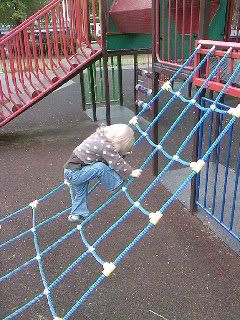All right, I'm through being facetious for the moment, and I'd like to put up a case study of my experience with art criticism/appreciation:
Mark Rothko and Jackson Pollock.
Here's some Wikipedia links, which I actually haven't read (yet):
http://en.wikipedia.org/wiki/Mark_Rothko
http://en.wikipedia.org/wiki/Pollock
Both are often referred to as Abstract Expressionists, though Rothko apparently didn't think his work belonged in that category, so I'll just set titles aside for the moment. Both artists explored what a painting can be, when you abandon traditional subject matter in search for something different.
For years, I saw reproductions of Rothko's work in art history books, and wondered what all the fuss was about.
Okay, he's not painting people, or flowers, or et cetera et cetera. He's looking at the impact of color on our emotions. But, hey, I just painted a wall in my apartment bright red. Sure, it's pretty. But so what?
Of course, at the time I probably didn't appreciate how difficult it is to reproduce color accurately for publication. But that's secondary to what happened next.
I went to the Met, here in New York. I think I was in high school.
There's a room, upstairs, that is pretty much made of a couple Rothko paintings. They're huge.
I stepped in, and everything changed.
For one, there's just no translating the effect of a giant mass of color in a reproduction in a book.
And the colors weren't flat. They hinted at hidden depths. One color played against another, vibrating in my brain.
I stood and stared. I felt outside the flow of time.
And I felt full of awe. In the old sense, Rum, it was awesome.
I get it. I get it now.
I couldn't shake the mood that room put me in, for days.
You want to talk visceral? That room was a punch right in the gut.
And all of a sudden, I understood why it was important that Rothko decided to look at what a painting can do, when one abandons traditional representation.
Oddly enough, now that I've had that in-the-flesh experience, I feel it (albeit at a much lesser extent) when I see his work published.
But that visceral experience has left me full of other questions, that can be explored through other avenues.
Why did that color affect me the way it did?
Is there something really physiological going on, in my response to it?
Would any person who could see those colors experience some kind of affect akin to what I felt, or was my response shaped by the culture in which I was raised, etc., etc.
What was Rothko like, that he could see this, and find a way to show it in his work?
Did the Catholic Church understand that response to color, and use it to manipulate the emotions of churchgoers, when It started employing stained glass in churches and cathedrals (for me, the emotional impact was similar.)
and so on and so forth.
Now, let's look at Pollock.
I'm not of the camp that sees his paintings and thinks:
he just threw paint at a canvas; or
my seven-year-old daughter could do that.
Setting aside possibly (probably) apocryphal stories that Pollock's swirls of paint describe fractal forms,
I've tried it. And while it was fun, my paintings didn't look a thing like his. Maybe it has something to do with the mechanics of his wrists and arms.
Although I didn't know at the time that he had a swing harness and suspended himself over some of his work.
And even if I did, none of my workspaces ran to those sorts of amenities.
(Though I have to think-- paint, swing harness, giant canvasses-- that could be a fun night with the right company.)
Anyway, while I understand what Pollock was doing, on some level, at least,
questioning what a painting can be, exploring the different ways to use paint to express ideas or emotions,
and I recognize that if he hadn't asked those questions or done that work, there's a lot of other art that might never have come to be,
When I look at his paintings, they leave me cold.
Sure, they look fun to make (though, knowing the little I do about Pollock's life, I guess it wasn't as fun as it looks.)
They're energetic.
But, for me at least, they never break through to something deeper-- that moment of timeless revelation I felt when I was in the Rothko room.
So I wonder,
Well, why is that?
And I try to figure it out. Which leads to other questions, that again aren't strictly about my emotional connection to the work,
even if that's what inspired them.
And i find it interesting.

